In the previous post in the series, we looked at the cerebrum. There will be a mention of it again in this post, but mainly I will explore the differences in the cerebellum and its functioning in the autistic brain. This will be an important post, because the cerebellum has emerged as one of the key brain regions affected in autism.[1]Chapter One – Autism Spectrum Disorder and the Cerebellum
Just like in the last post, I will explain what the cerebellum is and does first.
What is the cerebellum?
The cerebellum is a structure at the back of the brain (above the brainstem), as you can see in the diagram below. The name is Latin for little brain, though in some animal species the cerebellum is actually larger than the cerebrum. Autistics are not one of those animal species, however (in fact we are not a species).
The cerebellum plays an important role in motor control (regulation of movement), but some evidence suggests that it’s also involved in some cognitive functions (including attention and language), executive functions, as well as affective regulation, and regulating fear and pleasure responses.[2]Evaluating the affective component of the cerebellar cognitive affective syndrome[3]Consensus paper: the cerebellum’s role in movement and cognition[4]Chapter One – Autism Spectrum Disorder and the Cerebellum
The cerebellum does not initiate movement, however.* What it does is receive information from sensory systems (vision, hearing, touch, taste, smell, and balance), which it then integrates to regulate motor activity. It effectively compares the performance of a given movement with the original intent of the brain, and takes corrective action if necessary (see a simplified rendition of the process in the diagram below). As such, the cerebellum plays a major role in coordination, precision, and accurate timing.
- Movement is initiated by the primary motor cortex (located in the frontal lobe), which generates neural impulses that control the execution of movement.
So the cerebellum plays an essential role in motor control, and is important in certain cognitive functions—including speech—as well. I would just like you to note that motor control and communication are two core domains of autism. In other words, we can expect some significant differences in the cerebellum of autistic individuals.
Cerebrum & cerebellum
Finding: Increases in cerebral & cerebellar volumes[5]Magnetic Resonance Imaging and Head Circumference Study of Brain Size in Autism
Method: Magnetic resonance imaging (MRI)
A study from 2001 found that autistic 2–3-year-olds had:[6]Unusual brain growth patterns in early life in patients with autistic disorder: an MRI study
- 18% more white matter in the cerebrum compared to controls.
- 39% more white matter in the cerebellum compared to controls.
- 12% more gray matter in the cerebral cortex compared to controls.
These enlargements in gray and white matter volumes were not seen in older autistic children and adolescents, which seems to indicate that—just like the general brain enlargements as you might have read in Enlarged brains—there is likely a significant gray and white matter growth in these regions in the first years, but this growth rate decreases with age, and a few years later the gray and white matter volumes are roughly the same as in neurotypicals.
Cerebellar vermis
The study from 2001 also indicated that autistic boys showed less gray matter in the cerebellum, a smaller gray/white matter ratio, and smaller vermis lobules VI–VII than controls.[7]Unusual brain growth patterns in early life in patients with autistic disorder: an MRI study
More on these lobules in a moment. But this is interesting, because the cerebellar vermis (which the lobules are part of, and as depicted in the illustration below) contributes to whole-body posture and locomotion.
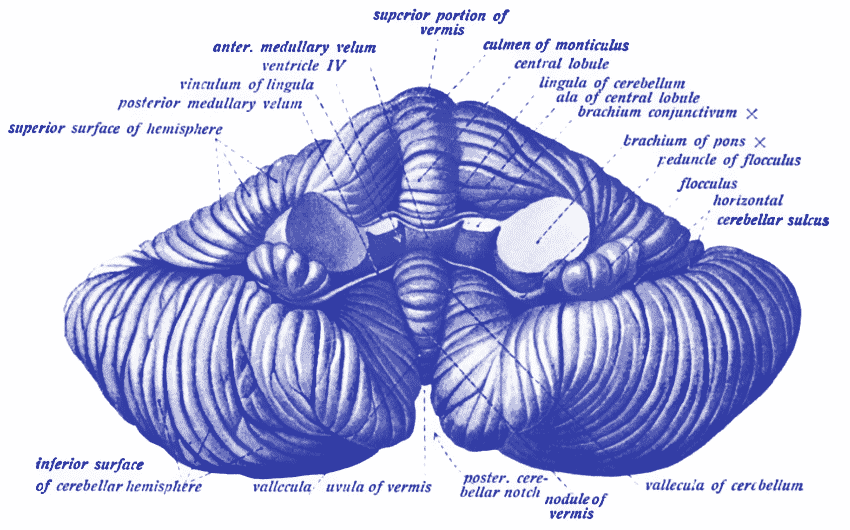
In my understanding, body posture and locomotion (the manner in which we move) are areas in which autistic people can show certain… let’s say idiosyncrasies. This certainly applies to myself as well. For example, when I stand I have the tendency to put my belly slightly forward, rather than my chest. Natalie occasionally reminds me I am standing around with a distinct lack of apparent neurotypicality.
Natalie: You’re standing like an autistic again!
Me: Oh, yeah.
It’s not that there is anything wrong with standing like that, but I like to maintain a better posture. Although, since I have slight scoliosis, I may also stand like this sometimes to alleviate the pressure in my lower back. I suppose sometimes it’s hard to say whether someone has autism or back pain!
In other ways perhaps I go a bit overboard with the posture. I have also been told I walk in a stiff manner, not unlike a military person (in fact when I was running on a treadmill during my teens, a classmate laughed and remarked how I looked like a marching soldier), but a better comparison that comes to my mind is the autistic detective Saga Norén from the Danish/Swedish series The Bridge, in case you have seen it (if not I highly recommend it). She has a rather mechanical walk, and keeps her back and neck straight. And so do I, though whereas the actress Sofia Helin put her craft and effort into that walk, to me the walk comes entirely natural and without effort!
I have practiced walking more fluently, and I have learned to move my head a little bit so as not to appear like a cyborg, but I reckon my walk is still somewhat idiosyncratic/robotic.
Vermis lobules VI–VII
Remember how the study from 2001 indicated smaller vermis lobules VI–VII than controls? Well, already in 1994 a study indicated that the vermis lobules VI–VII (pictured in the diagram of the cerebellum below) may be affected in most people with autism.[8]Abnormality of cerebellar vermian lobules VI and VII in patients with infantile autism: identification of hypoplastic and hyperplastic subgroups with MR imaging
The study from 1994 found—just like the study from 2001—that most autistics have smaller vermis lobules VI-VII, but they found two subgroups of autistic patients:[9]Abnormality of cerebellar vermian lobules VI and VII in patients with infantile autism: identification of hypoplastic and hyperplastic subgroups with MR imaging
- Group 1 (86%) — Autistic individuals with vermian hypoplasia (underdevelopment of the vermis lobules VI–VII)
- Group 2 (12%) — Autistic individuals with vermian hyperplasia (enlargement of the vermis lobules VI–VII)
The mean area of lobules VI–VII was found to be 16% smaller in the hypoplasia group compared with controls, and 34% larger in the hyperplasia group compared with the mean area of controls.[10]Abnormality of cerebellar vermian lobules VI and VII in patients with infantile autism: identification of hypoplastic and hyperplastic subgroups with MR imaging
Motor challenges
Already in 1943, Leo Kanner in his paper Autistic disturbances of affective contact—and the following year Hans Asperger in his paper Autistic psychopathy in childhood—noted awkward motility and clumsiness in their autistic subjects.[11]Consensus paper: pathological role of the cerebellum in autism Even two decades before that (and truly ahead of her time), Grunya Sukhareva’s autistic subjects were admitted to a therapeutic school, and received both social and motor skills training during their classes.[12]Sukhareva—Prior to Asperger and Kanner
Now we have a greater understanding of these motor impairments, and the role the cerebellum plays in these impairments—or perhaps rather motor alterations. Emerging research indicates impairments/alterations in cerebellar maintenance of posture, balance, motor dexterity, and coordination of movement in some autistic individuals.[13]Motor Coordination in Autism Spectrum Disorders: A Synthesis and Meta-Analysis[14]Underdevelopment of the postural control system in autism
A study from 2003 for example documented impaired vestibular control,[15]Postural stability in children with autism spectrum disorder meaning alterations in the sense of balance and spatial orientation, which further affects movement. Limbs might for example sort of wander around in space without necessarily being aware of them—sometimes as part of stimming behavior.
And a study from 2007 indicates gross and fine motor abnormalities similar to those demonstrated by patients with established cerebellar disease.[16]Quantitative assessment of neuromotor function in adolescents with high functioning autism and Asperger Syndrome
In a prospective study from 2008, motor impairments in infants were even found to be one of the first signs of the autism phenotype.[17]Gross motor development, movement abnormalities, and early identification of autism
And a meta-analysis from 2010 indicated substantial motor coordination deficits and postural stability issues in autistic participants, as you can see in the forest plot below, with an overall standardized mean difference effect equal to 1.20 (anything on the right side of the central line constitutes motor impairments).[18]Motor Coordination in Autism Spectrum Disorders: A Synthesis and Meta-Analysis
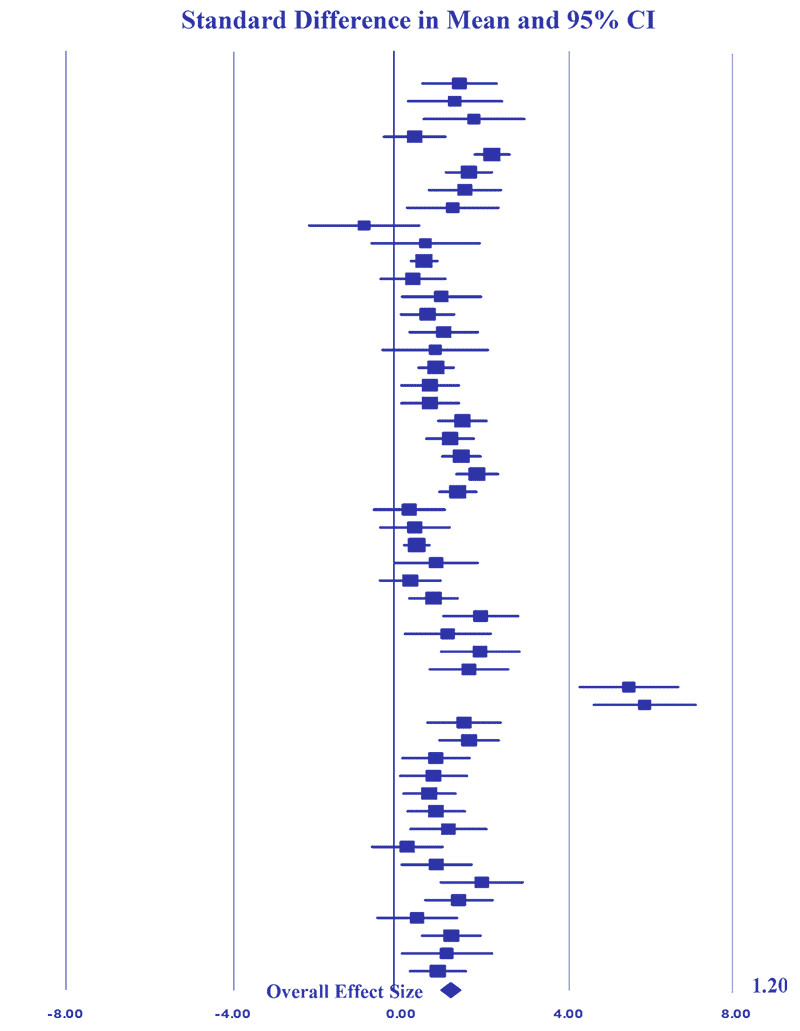
Martin’s motor magic
Personally, I grew up with certain developmental delays, among which terrible gross motor skills. My parents made me do gymnastics and Judo (the meaning of which is gentle way, which describes me well, but not in terms of martial talent), so I got to practice somersaults and hopscotches and such. I had a lot of difficulty doing the kind of physical things that come naturally to most children, and I underwent years of therapy to practice my motor skills. The underlying issues, I suspect, are balance and coordination.
These issues did not only manifest when it comes to somersaults and such—an activity which could hardly be considered essential in life to master, and in fact it makes for a poor method of transportation. As kids, me and my siblings had to prepare the table for dinner every day, and it was my job to pour drinks and bring them to the dinner table. Arguably this was not a good job for me to do—or maybe it was, to practice my motor skills—because almost every day, I would either overpour the glasses or spill drinks, or both; and sometimes several times per week I would drop and break a glass, have to clean it up, and engage in a minor meltdown, because I was so desperate that I “did it again”. So my motor impairments caused almost daily issues in conventional tasks.
My fine motor skills, on the other hand, have always been excellent, and I have seen a plethora of anecdotal evidence that fine motor skills can be very advanced in people with autism, and so we often show particular talents in activities related to fine motor skills. Either way, my fine motor skills were most prominently expressed in drawing—an activity I would partake in most of the time when awake. When I was around 4, my teacher told my parents that my drawing skills were years ahead of my classmates’. Now as an adult my talents don’t stand out as much as they did back then, but they are still substantial, and in stark contrast with my gross motor skills, which still leave a lot to be desired.
In fact, I am writing this article while one of my toes is taped to another, since I broke my toe a bit over a week ago. I thought our living room table was tame, but as I walked to the kitchen, without warning the table attacked me with its rhinoceros-like legs! The results of the barbaric attack can be seen in the image below.
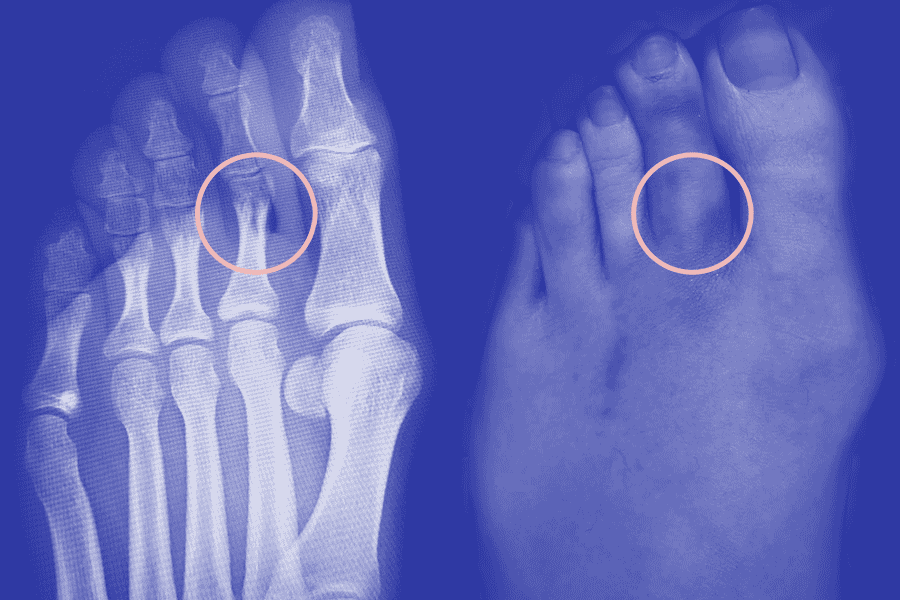
I have always been particularly gifted at walking into things, either with feet or with my head. It’s almost magical how long I can maintain a spectrum of colors from blue to yellow on my feet.
- Update: Yesterday I slipped and hurt my broken toe very badly. I went back to the doctor, and he didn’t think another X-ray was necessary, but advised me not to hit my toe again. Guess what I did today? The level of pain each time I hit it again is astounding.
Update: That very evening I hit my toe again!
Mind you, Natalie is very much like me. We might as well call ourselves the Habitually Bruised Duo. So to address any potential future concerns about domestic abuse: no, we are autistic, and sadly do all of this to ourselves.
Core autism symptoms
A study from 2015 indicated that gray matter in the cerebellum and the volume of the lobules correlate with core autism symptoms.[19]Cerebellar gray matter and lobular volumes correlate with core autism symptoms
Gray matter in the cerebellum was found to be reduced in several regions in children with autism, and the extent of gray matter reduction was found to correlate with the severity of core autism symptoms in social interaction, communication, and repetitive behaviors. Structural differences that correlated with these core autism symptoms were found on lobule VII (Crus I/II), as you can see in the table below.[20]Cerebellar gray matter and lobular volumes correlate with core autism symptoms
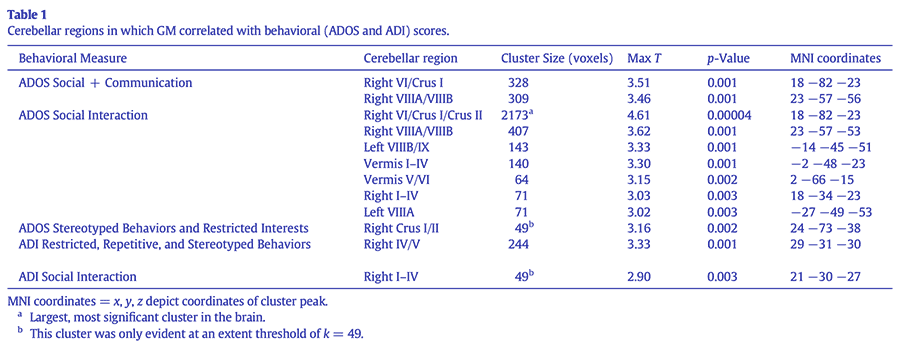
In the image below you can see these different cerebellar regions and which core domain they belong to.
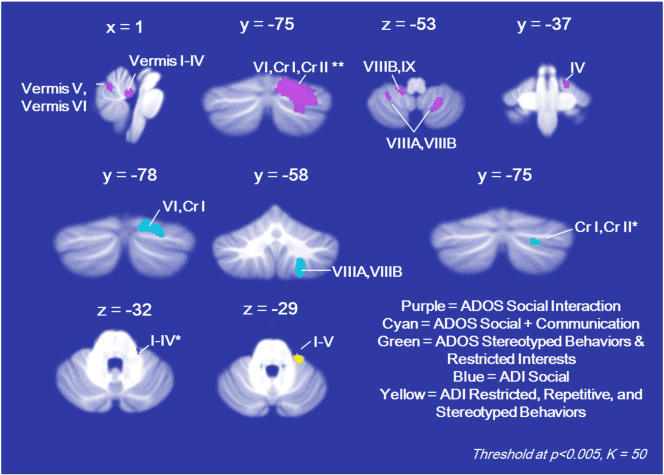
Social cognition
A multi-study analysis from 2015 that looked at 5 studies—as well as a meta-analysis from 2013 that looked at 350 fMRI studies—implicated the cerebellum and cerebrum in social cognition.[21]Functional connectivity between the cerebrum and cerebellum in social cognition: A multi-study analysis[22]Social cognition and the cerebellum: A meta-analysis of over 350 fMRI studies
The meta-analysis from 2013 found the following:[23]Social cognition and the cerebellum: A meta-analysis of over 350 fMRI studies
- The cerebellum is minimally involved in conditions that trigger the mirror network (I assume this means activations of mirror neurons).
- The cerebellum is minimally involved during social mentalizing.
- The cerebellum is strongly involved in abstraction in mentalizing (traits, stereotypes, one’s future…).
The cerebellum is strongly involved in particular when:
The level of abstraction is high, such as when behaviors are described in terms of traits or permanent characteristics, in terms of groups rather than individuals, in terms of the past (episodic autobiographic memory) or the future rather than the present, or in terms of hypothetical events that may happen.[24]Social cognition and the cerebellum: A meta-analysis of over 350 fMRI studies
In the table below, you can see the percentage of the 350 fMRI studies in which the left and right side of the cerebellum were implicated when it comes to various cognitive and motor tasks, with the categories with the highest involvement highlighted.[25]Social cognition and the cerebellum: A meta-analysis of over 350 fMRI studies
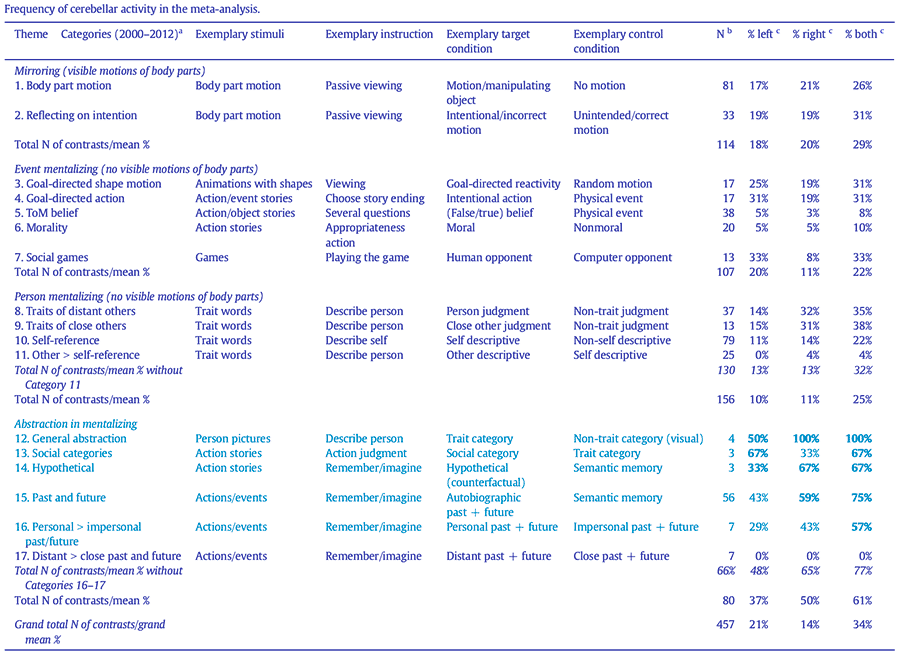
I find it interesting that these items are highlighted, considering in my experience autistic people are often very reflective (thinking about past and future), and I have personally observed a lot of autistic philosophers, or otherwise autistic people with a propensity for logic and abstract thinking. And while some research indicates autistic traits correlate with convergent thinking (being able to give correct answers without any creativity),[26]An investigation into the relationships between convergent and divergent thinking, schizotypy, and autistic traits when it comes to high-functioning autistics, I have often observed an impressive ability for divergent thinking (a creative method of thinking that generates a lot of solutions), though admittedly we can engage in either, depending on whether we find ourselves in a dysregulated state or not.
So perhaps these areas of the cerebellum are not affected, or they are affected, with (arguably) advantageous consequences—at least in higher IQ autistic individuals.
The meta-analysis also showed that areas of the cerebellum that are consistently involved in social cognition show significant overlap with the areas involved in sensorimotor (during mirror and self-judgments tasks) as well as in executive functioning (across all tasks).[27]Social cognition and the cerebellum: A meta-analysis of over 350 fMRI studies
This is also interesting, because executive function challenges are common among autistic people,[28]Executive Function Deficits in High‐Functioning Autistic Individuals: Relationship to Theory of Mind and social challenges are one of the core domains of (a pathological clinical description of) autism. So I am assuming from the overlap between these areas, that in autism there is also a link between executive functioning and social cognition.
Social reward
In a new study from 2019, researchers looked at the cerebellum in mice, and found a direct pathway from the nuclei of the cerebellum to the ventral tegmental area (VTA), which is the brain’s reward center.[29]Cerebellar modulation of the reward circuitry and social behavior
As such, although this pathway is not prosocial on its own, the cerebellum does contribute to showing social preferences and motivations.[30]Cerebellar modulation of the reward circuitry and social behavior The reason this is relevant to autism is because the functioning of the cerebellum in the autistic brain could be related to the social motivation theory of autism, which posits that social motivation deficits play an essential role in autism:
We conclude that ASD can be construed as an extreme case of diminished social motivation and, as such, provides a powerful model to understand humans’ intrinsic drive to seek acceptance and avoid rejection.[31]The social motivation theory of autism
So while the pathway between the cerebellum and the VTA in autism is not yet well studied, research on the VTA in autism does implicate it in a lesser social reward, which in turn diminishes sociability.[32]Gating of social reward by oxytocin in the ventral tegmental area This is not to say we are necessarily asocial, but, as Tony Attwood said:
An Aspie is someone who has found something
to be more interested in than socializing.[33]Video: Tony Attwood – Aspergers in Girls (Asperger Syndrome)
Cerebellar pathology
In the table below you can see how a myriad of conditions are linked to autism genes, and which affect the cerebellum in various ways.[34]Consensus paper: pathological role of the cerebellum in autism
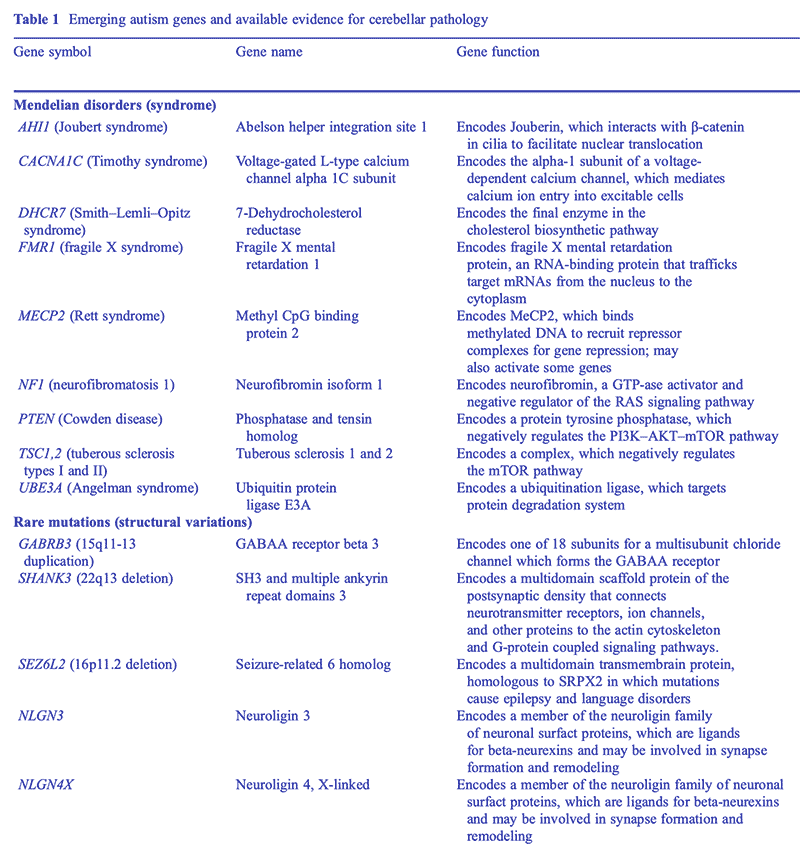
Although these conditions are rare, autism does have a high co-occurrence rate with these conditions, which makes sense given that they share gene expressions and particular (dys)functions of the cerebellum.
- Joubert syndrome — 25% meet the criteria for autism,[35]Autism and autistic behavior in Joubert syndrome while 40% show at least some autistic features.[36]Autistic features in Joubert syndrome: a genetic disorder with agenesis of the cerebellar vermis
- Timothy syndrome — 80% of those who survive long enough for evaluation meet the criteria for autism.[37]CaV1.2 Calcium Channel Dysfunction Causes a Multisystem Disorder Including Arrhythmia and Autism
- Smith–Lemli–Opitz syndrome — 50–75% meet the criteria for autism.[38]Smith–Lemli–Opitz Syndrome and Autism Spectrum Disorder
- Fragile X syndrome — 15–60% meet the criteria for autism.[39]What Can We Learn about Autism from Studying Fragile X Syndrome?
- Rett syndrome — Although the diagnostic system prevents individual with Rett syndrome from being diagnosed with autism, 42–58% meet the criteria for autism (albeit 19% no longer meet the criteria as they develop).[40]Autistic disorder symptoms in Rett syndrome
- Neurofibromatosia type 1 — 25% meet the criteria for autism, and 21% meet the criteria for broad autism phenotype.[41]Neurofibromatosis Type 1 and Autism Spectrum Disorder
- Cowden syndrome — Autistic features have been observed, though I have not found any research on comorbidity with autism.
- Angelman syndrome — 24–81% meet the criteria for autism.[42]Autism spectrum disorders in genetic syndromes: implications for diagnosis, intervention and understanding the wider autism spectrum disorder population[43]Prevalence of autism spectrum disorder phenomenology in genetic disorders: a systematic review and meta-analysis
Motor impairments underpin most of these conditions. Damn cerebellum!
- NB: Andy Warhol is believed to have been autistic, so at one time he too would have had an increase of white matter in his cerebellum. Good to know, no?
I have left a few interesting research studies on the cerebellum undiscussed. For now, I will leave it for what it is, and open another can of worms sometime after completing the initial run of the brain anatomy series. I will tell you all about Purkinje cells and other interesting bits then.
Comments
Let us know what you think!